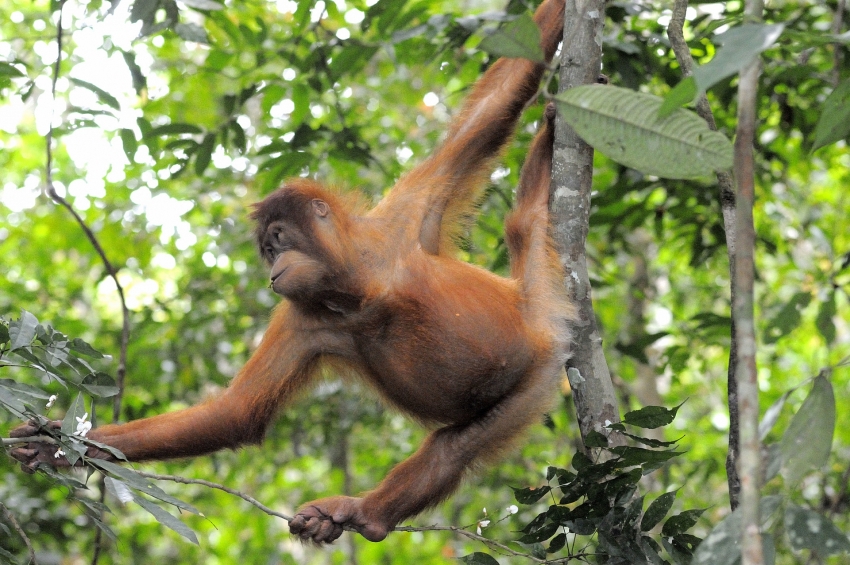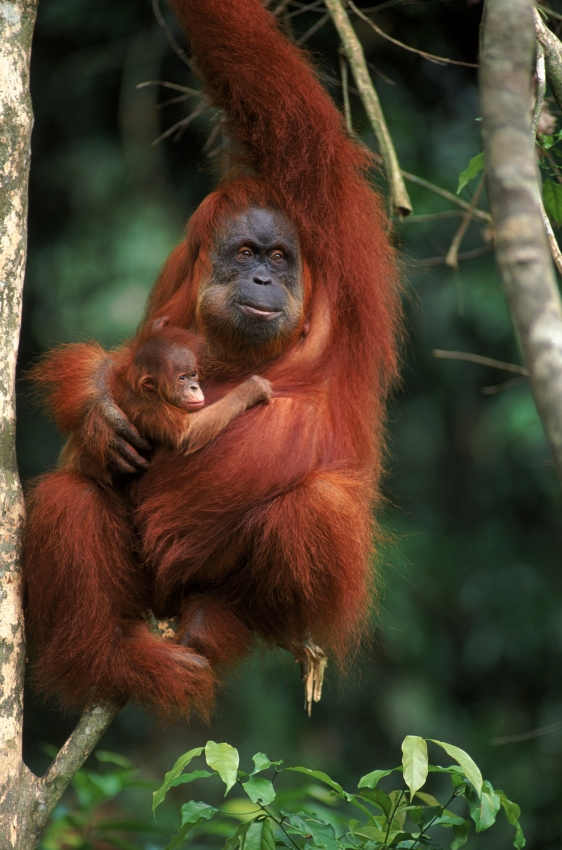Amazon Web Services joins efforts to protect biodiversity
 |
| Vincent Quah, regional head – Education, Research, Healthcare, and Nonprofit Organizations, Asia-Pacific, Worldwide Public Sector, Amazon Web Services |
 |
| Aria Nagasastra, director of Finance and Administration, WWF-Indonesia |
How can AWS’ technology play an important role in protecting orangutans and the biodiversity in Indonesia?
Quah: AWS is involved in the business of delivering services like computing power, databases, storage applications, analytic services, and even advanced services like AI and machine learning. We provide our customers rapid, flexible, and low-cost access to the IT resources that we provide.
We have millions of active customers in more than 190 countries worldwide, ranging from the largest of companies to small- and medium-sized enterprises and startups, and of course, to government institutions, education institutions, as well as non-profit and not-for-profit organisations like WWF-Indonesia.
We see our role in empowering organisations like WWF-Indonesia with cloud technology to do the great things that they are doing and build a better world. We look at the work they do from the perspective of effectiveness and efficiency and see how better they could use technology.
Nagasastra: As a non-profit, we are always looking for ways to work smarter and apply our resources more effectively to better carry out our conservation mission. Using AWS services like Amazon SageMaker and Amazon Simple Storage Service (Amazon S3), we are making a tool for field surveyors, even with limited expertise and capacity, to identify wildlife in its natural habitat with a high degree of accuracy. With the careful use of technology, this innovation will help biologists and conservationists to effectively and cost-efficiently monitor wildlife behaviour, which will enable us to allocate our resources to scale up monitoring efforts and invest more in conservation actions.
The collaboration between WWF-Indonesia and AWS on innovative new technology solutions can elevate biodiversity conservation practices in Indonesia to the next level.
 |
Vietnam is now home to a number of animals that are in danger of extinction. Should the country use AWS machine learning to protect them or other kinds of technology?
Quah: For the case of orangutans, we want to learn about their behaviour, how they use their environment and so on. Many species have very different contexts, for instance, the need for breathing. Maybe we can use this kind of approach but for a different purpose. There are many opportunities through a similar meaning that we can create many other purposes. This is very important for conservation goals in Vietnam. Conservation objectives should be identified before we decide on the kind of technology to use.
One recommendation that I can make to the organisations in Vietnam that are tasked with the conservation of some of these animal species: it'd be great if a meeting on conversation between them and WWF could be organised and they would see some of the efforts that WWF has done through this experiment with our technological support. And of course, we can come in and help by recommending some of the technologies that can be used.
 |
Innovations are key to AWS. Does AWS have a plan to develop new and more useful products than the machine learning to better protect biodiversity?
Quah: As a company, our pace of innovation is unmatched on a year to year basis. For example, in 2018, we've released about 1,957 different new services and features to our customers and the year before, in 2017, that number was about 1,400 new services and features.
The rate of innovation that is coming from AWS is great, really growing at a rapid pace. And that is really a very unique way in which we work with our customers. In fact, our customers tell us what are some of the new capabilities that they want to see from AWS, and we innovate new features and services to meet those requirements. Close to 90 per cent of our roadmap actually comes from ideas and talking to our customers and understanding what our customers want to achieve. We're constantly adding new services like AWS SageMaker to a whole slew of Machine Learning Services, making it one of the big areas of new capabilities that we are delivering all the time.
I'd like to bring two interesting stories from Australia and New Zealand as evidence of how we are supporting biodiversity protection. The first one is our co-operation with the University of Sydney in their effort to understand some of the endangered species. The Tasmanian devil is native just to Australia. And the researchers in the University of Sydney use the AWS platform to work on data sets and to collaborate for getting the results faster. So they were able to complete more than 50 genetic analysis in just 12 weeks, which otherwise would have taken them months. And then they are sharing this data set across their research community and making it available.
The second example is a story from the Department of Conservation, New Zealand. They were working to improve the conservation of some endangered birds. One of those birds that they were working on is called Kakapo, an owl parrot – very unique indigenous one. An intersting statistics of this story was that there were 200 Kakapo birds reported in August 2019, a really good breeding season from only 137 birds six months before that. The important part of it is the database that the Department has built to identify the behaviours of the birds. Each bird is tagged with an RFID tag, so they literally can trace and know a lot of the details of the birds’ adult life. How, and who is socialised with, how much food they eat, so on and so forth. All these things are captured in AWS services and using analytic tools and machine learning to analyse those data.
| Orangutans are among the most intelligent primates on earth, capable of constructing, using tools, and living in colonies with distinct cultures. Human activities including poaching, destruction of habitat, and the illegal pet trade have caused severe declines in the orangutan population, which is comprised of three species of great apes native to Indonesia and Malaysia. According to WWF, Bornean orangutan populations have declined by more than 50% over the past 60 years and the species’ habitat has been reduced by at least 55% over the past 20 years. Orangutans are largely solitary and spend much of their lives in trees, complicating conservationist efforts to accurately measure remaining populations. Since 2005, WWF-Indonesia has assessed the health of orangutan populations and conserved their 568,700-hectare habitat in Sebangau National Park in Central Kalimantan, Indonesia. Previously, the assessment required experts and local community volunteers going into the field daily to find orangutans, photograph them, download images to local computers at the basecamp, and transport the data back to the city for analysis by a WWF expert. This manual process took WWF-Indonesia experts up to three days to analyse each batch of thousands of photos, a process that could be error-prone due to the volume of data. Using AWS, WWF-Indonesia now automatically gathers images from mobile phones and motion-activated cameras at its basecamp and uploads these to Amazon Simple Storage Service (Amazon S3) where they are analyzed. Using technologies including Amazon SageMaker, a fully-managed machine learning service that allows data scientists and developers to quickly and easily build, train, and deploy machine learning models at scale, WWF Indonesia has reduced its analysis time from up to three days to less than ten minutes. It has also been able to increase the accuracy and specificity of its data, which includes measurements such as gender ratio and age, assess the viability of populations, and quickly identifies whether individuals are pregnant, ill, or suffering from injuries which require immediate treatment. By adopting machine learning, WWF-Indonesia has reduced its reliance on a limited pool of conservationist experts and improved the accuracy and breadth of its data about orangutan populations. In the future, WWF-Indonesia plans to explore the use of additional machine learning services, such as Amazon Rekognition, an image and video analysis service, to further improve the speed and accuracy of its population identification and tracking efforts. |
What the stars mean:
★ Poor ★ ★ Promising ★★★ Good ★★★★ Very good ★★★★★ Exceptional
Related Contents
Latest News
More News
- Stakeholders mobilised before new child safety rules take effect (December 10, 2025 | 09:00)
- Vietnam receives emergency international relief as regional flooding intensifies (December 04, 2025 | 15:11)
- AmCham scholarships awarded to students (December 02, 2025 | 16:46)
- Vietjet flights carry love to devastated central region (November 28, 2025 | 11:35)
- SCG Sharing the Dream supports Vietnam’s youth and sustainable development goals (November 28, 2025 | 10:55)
- Siemens Caring Hands donates $34,700 for disaster relief in Vietnam (November 26, 2025 | 20:25)
- Ireland extends support for the Resilience First initiative (November 26, 2025 | 15:24)
- South Korea funds IOM relief for Vietnam’s typhoon-affected communities (November 24, 2025 | 15:33)
- SABECO concludes 'Legacy on the Move' series in Hanoi (November 17, 2025 | 18:01)
- New Zealand commits $570,000 to support Vietnam’s post-disaster recovery (November 14, 2025 | 17:44)

 Tag:
Tag:























 Mobile Version
Mobile Version